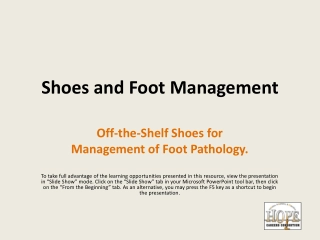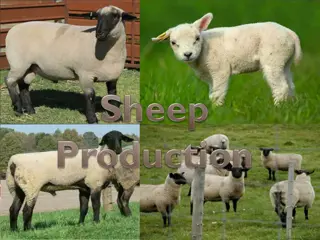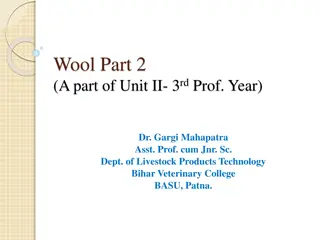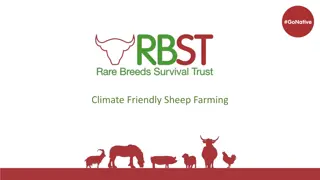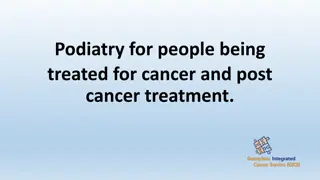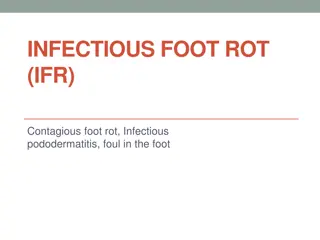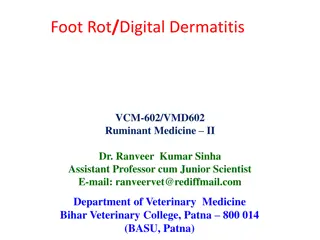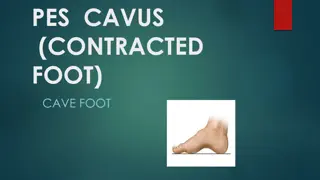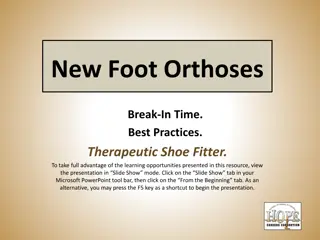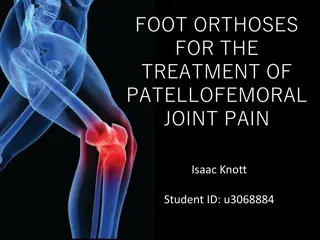Understanding Foot Rot in Sheep: Causes, Transmission, and Clinical Findings
Foot rot is a contagious disease in sheep caused by anaerobic bacteria. It leads to lameness and economic loss. This article discusses the etiology, classifications, epidemiology, transmission, pathogenesis, and clinical findings of foot rot in sheep.
Download Presentation

Please find below an Image/Link to download the presentation.
The content on the website is provided AS IS for your information and personal use only. It may not be sold, licensed, or shared on other websites without obtaining consent from the author. Download presentation by click this link. If you encounter any issues during the download, it is possible that the publisher has removed the file from their server.
E N D
Presentation Transcript
Foot rot by Dr. Hussein Al Naji
Foot rot It is an infectious, contagious disease of sheep that causes severe lameness and economic loss from decreased flock production. Etiology O vine foot rot is caused by an interaction of two anaerobic (without oxygen), Gram (bacteria,( Dichelobacter) Bacteroides nodosus (formerly Fusiformis nodosus) and Fusobacterium necrophorum (formerly Sphaerophorus necrophorus).
Two classifications of foot rot have made based on the site of survival and perpetuation of the organism in a flock and the importance of this to control strategies: 1. Virulent foot rot (progressive foot rot) and intermediate foot rot - strains survive between foot rot transmission periods in pockets in previously underrun ovine hoof 2. Benign foot rot (non-progressive foot rot) - strains survive in the interdigital skin and the organism can be demonstrated in interdigital skin of a high proportion of asymptomatic sheep
EPIDEMIOLOGY Geographical occurrence Foot rot of sheep is common in all countries where there are large numbers of sheep. Host occurrence Sheep are the species principally affected but goats are also susceptible. With environmental conditions of moisture and warmth, the disease in sheep has a high attack rate
Transmission Its spread from infected sheep to the ground, manure, bedding, etc., where it is then picked up by noninfected sheep. Foot rot is introduced by purchase of an infected animal or by simply using facilities or trucks that have been contaminated by infected sheep. Spread occurs best when temperatures are from 10 C and the environment is wet.
Pathogenesis Maceration of the interdigital skin from prolonged wet conditions underfoot allows infection with F. necrophorum. This initial local dermatitis associated with infection with F. necrophorum at the skin and the skin-hom junction may progress no further, but the hyperkeratosis induced by this infection facilitates infection by D. nodosus if it is present. The preliminary dermatitis has been named 'ovine interdigital dermatitis' and is also called 'foot scald'.
CLINICAL FINDINGS Sheep Virulent foot rot In a flock, a sudden onset of lameness of several sheep is the usual presenting sign of foot rot. The pain associated with infection is severe and affected sheep will limp or carry the affected leg. The underrunning starts as a separation of the skin-horn junction at the axial surface. There is a distinctive, foul-smelling exudate, which is always small in amount.
Abscessation does not occur. A systemic reaction, manifest by anorexia and fever, may occur in severe cases. Recumbent animals become emaciated and may die of starvation. Secondary bacterial invasion and/or fly strike may result in the spread of inflammation up the legs.
Benign foot rot Benign foot rot is manifest with interdigital lesions, a break at the skin- horn junction and separation of the soft horn, but the disease does not progress beyond this stage to severe underrunning of the hard horn of the foot. The interdigital skin becomes inflamed and covered by a thin film of moist necrotic material; the horn is pitted and blanched. Diagnosis A smear made of exudates taken from underneath some under horn at the advancing edge, and stained with Gram's stain. PCR tests can be used to detect gene sequences. An ELISA for serological detection of infected sheep.
Differential diagnosis Foot abscess, It usually affects only one foot, is not contagious and is characterized by extensive suppuration. Contagious ovine digital dermatitis. Shelly toe, Suppurative cellulitis_ associated with F. necrophorum, commences as an ulcerative dermatitis of the pastern above the bulb of the heel, and extends up the leg to the knee or the hock, Other diseases with foot lameness include: Contagious ecthyma Bluetongue Foot and mouth disease Ulcerative dermatosis Strawberry foot rot Laminitis Lameness associated with Erysipelothrix insidiosa, and occurring after dipping
Treatment The control of ovine foot rot is based on several management practices that decrease predisposing factors, and on the treatment and immunization of infected and susceptible sheep. Foot trimming: This reduces the number of cracks and crevices where bacteria can hide, removes infected hoof, and exposes the organism to air and various medications. Footbaths/Footsoaks: There are two different types of solutions commonly used in foot baths: (a) zinc sulfate (10% solution) and (B) copper sulfate (10% solution) they should be used 1-2 times per week for several weeks. They may also be used routinely after foot trimming and as a preventative.
Dry chemicals: Zinc sulfate (dry) can be placed in a box in an area sheep must walk through don t for treatment but to decrease the spread the infection. Oral therapy: Zinc sulfate at the rate of 1/2 (0.5) gram per day for 21 days may be helpful both in treatment and prevention, especially if the diet is zinc-deficient. Injection of antibiotics: Penicillin and streptomycin combinations used either as a one-shot treatment (1 ml/8 pounds) or every day up to ten days Procaine Penicillin G or long-acting penicillin products at the same dosage may also be effective. Single injections of long-acting tetracycline have also been successful in some cases.
Topical medications: There are several different medications that can be applied to the hoof immediately after paring that are helpful in controlling foot rot. Zinc sulfate (10%) - 1/4 (0.25) pound in one quart of water. Copper sulfate (10%) in vinegar - 1/4 (0.25) pound in one quart vinegar. Copper sulfate in pine tar - 2 parts CuS04in one part pine tar. Oxytetracycline solution in alcohol - one 25.69-gram pkg to 1/2 cup water, then add alcohol to bring solution to 2 quarts. Penicillin in alcohol - 5 million units of potassium penicillin G with 10 cc (ml) water, then add to 1 quart alcohol. Vaccination: Vaccines for Bacteroides nodosus are approved for use in the U.S.


